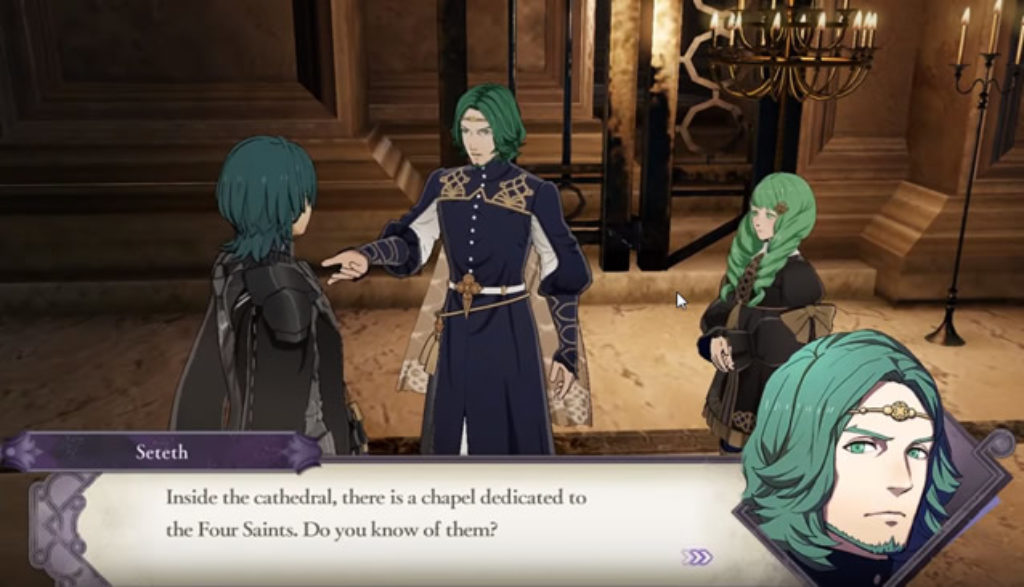
Fire Emblem: Three Houses is the latest in a strategy role playing series that’s been around for a good long time. And now that the action is moving to the Nintendo Switch, away from the miniature handheld realm of the Nintendo 3DS, this entry has gotten a lot of attention for its innovative adjustments to the franchise’s formula.
If you’ve never played a Fire Emblem game before, they’re all broad fantasy adventures set in different kingdoms, and they’re packed with magic-blasting and sword-swinging conflicts. Gamers are tasked with taking their chosen forces of specifically skilled characters into strategic, chess-like battles on grid-based maps.
Three Houses mixes up the battle-after-battle formula, however, with a lot more character interaction and relationship bonding than in past games. It does so by setting all the early game action in a huge school called the Garreg Mach Monastery. Some have likened that fortress-like locale to Hogwarts in the Harry Potter saga. Only in this case, the place is more of a church and/or officer’s academy that houses and trains the recruits from nations that contribute young people to its student body.
The teens in the school are learning battle strategy rather than just a bit of magic-casting. You play as one of the instructors, a young mercenary with a mysterious past who’s just come to the school. Oh, and the Dumbledore-like headmaster is a female archbishop of the church who routinely orders one or all of the three separate classes of students into battles—with each other or against outside forces that are threatening the monastery.
And, of course, there’s a much bigger and powerful kingdom-wide threat afoot, too.
This school setting makes a big difference when it comes to connecting with the game’s characters. You may be picking up this title for its strategic battles on the field. But Three Houses makes sure that you’re getting to know your chosen group of students—either the house of the Black Eagles, the Blue Lions or the Golden Deer—first and foremost.
There’s a battle to play out once a month, but the rest of the time is spent instructing those young students: shaping their skill sets, learning their strengths, hearing their stories and watching them grow into the team, and the young men and women, they will soon become. If you’re more action-focused, you can skip those instructive lessons, lunches, tea times and monastery quests, but the game makes sure that you and your charges will be the lesser for it.
Choosing a more fully fleshed-out character interaction actually makes the on-field battles much more engaging. Yes, you have a hands-on connection with weapon skill sets and the like. But seeing your students use the new skills they’ve gained, in a fast-paced and sometimes difficult conflict, makes all of the action more satisfying.
You become proud of that teen archer who was overly shy and who has since come out of her shell thanks to your tutelage. You care for that young noble who was scarred by a past tragic death of someone dear. You bond with these young people who ask openly for your guidance. And with time, their stories all begin to feel interconnected, a bigger part of the world picture at large.
For that matter, if you play on the game’s hardest difficulty level—a setting that results in fallen soldiers actually dying and being permanently removed from play—that can make for truly nerve-wracking strategic choices. The battles are relatively bloodless (with only a few cutscenes sporting a bit of blood splash), but seeing a good friend fall because of your order has an impact. A loss can become surprisingly emotional.
Investing in the people around you can result in some other connections, too. The game has a set of letter ranks that represent how close characters become. The higher the letter rank, the more readily they’ll team up and help each other in battle when standing side by side.
Off the field, though, that closeness can open the door for romantic conversations in private. There’s nothing here outside of some flirting, some winks at revealing female costumes and confessions of love, but things can lead to offers of marriage by the games end.
And it’s also important to note that Three Houses offers gameplay options for same-sex romances, too. In fact, some major characters can only be wooed through LGBTQ romantic overtures. For young gamers (and their parents), those unexpected conversations can be problematic and confusing, especially for younger gamers who may not even understand exactly what’s going on in these same-sex connections. It’s a trend that we’re seeing in many entertainment properties aimed at kids these days. And video games are no exception, as Three Houses unfortunately proves.
Some parents will find this game’s spiritual vibe to be a bit troublesome, too. There is a polytheistic battle at the core of the central conflict here, as well as dark, demonic magicking and monsters in Three Houses’ fantasy story. Humans transform into beasts, and good and evil can at times appear interchangeable. There’s also an occasional use of “h—” and “d–n” in the language mix.
All of that to say that Fire Emblem: Three Houses has indeed seen some pretty big changes. Of course, big changes aren’t always for the better.

After spending more than two decades touring, directing, writing and producing for Christian theater and radio (most recently for Adventures in Odyssey, which he still contributes to), Bob joined the Plugged In staff to help us focus more heavily on video games. He is also one of our primary movie reviewers.